Key takeaways:
- Tailoring workshops to the audience’s needs enhances engagement and fosters meaningful connections, leading to a more impactful learning experience.
- Active listening and audience analysis, including pre-workshop surveys, are essential for understanding participants’ interests and adjusting content dynamically.
- Incorporating interactive elements like gamification and real-time feedback encourages participation and creates a collaborative learning environment.
- Reflecting on workshop effectiveness through participant feedback and informal debriefing allows facilitators to continuously improve future sessions.
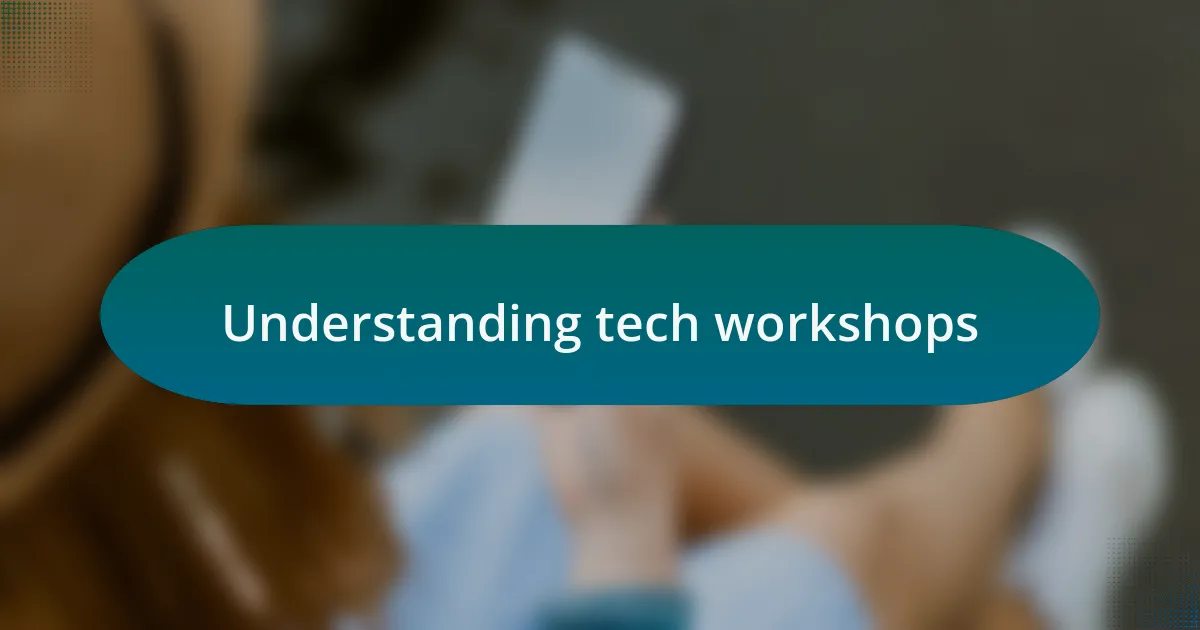
Understanding tech workshops
Tech workshops are more than just lectures; they are dynamic environments where learning and collaboration happen simultaneously. I remember attending a workshop focused on artificial intelligence, where the hands-on projects ignited my curiosity. The excitement in the room was palpable as participants delved into code and shared insights, bringing abstract concepts to life.
Every audience has unique needs and backgrounds, which is why it’s essential to tailor the content accordingly. Have you ever sat through a session that felt too basic or overly complex? I’ve been there, and it’s frustrating. I strive to strike the right balance, ensuring that everyone, from beginners to advanced tech professionals, can take away something valuable, sparking that all-important “aha!” moment.
The best workshops are interactive and foster genuine connections among participants. I once facilitated a session where we broke into small teams to solve real-world problems. The energy was infectious, and the solutions we crafted together were often more innovative than I could have imagined. It’s in these collaborative settings that true learning occurs, leaving participants inspired and eager to apply their newfound knowledge in their daily work.
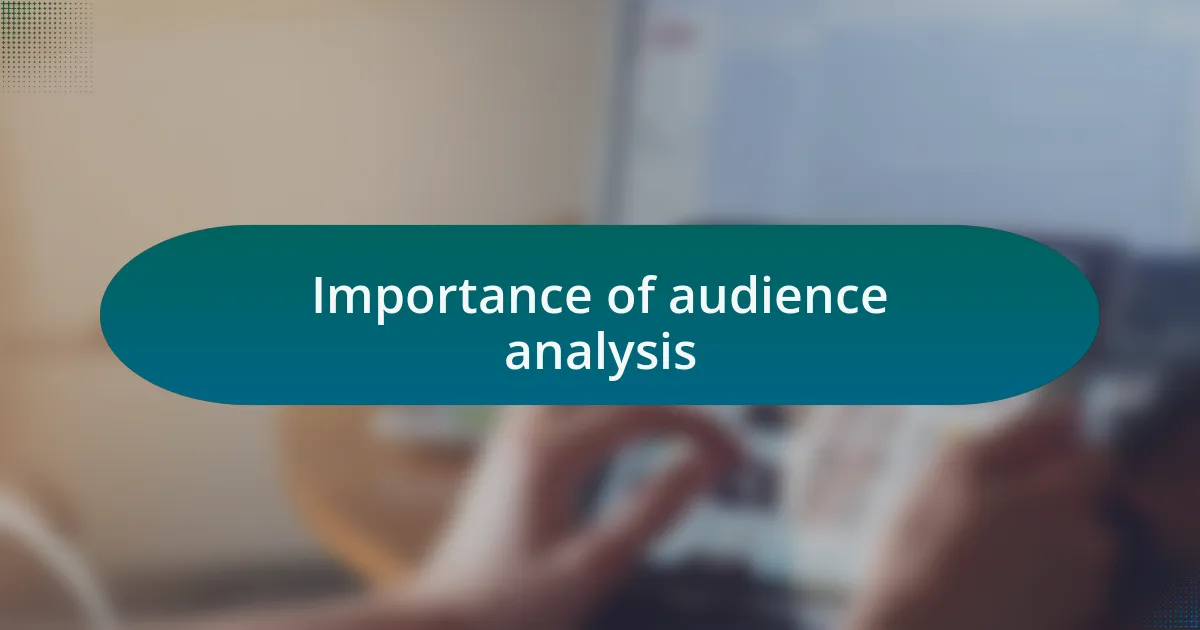
Importance of audience analysis
Understanding your audience is the bedrock of any successful workshop. I’ve noticed that when I take the time to analyze who will be in the room, the energy shifts dramatically. For instance, I once conducted a workshop for entry-level developers and another for seasoned veterans, and the difference in engagement was striking. Tailoring my approach allowed me to shift from basic concepts to advanced discussions, making everyone feel included and motivated to participate.
Without audience analysis, you run the risk of losing your participants’ attention. Have you ever been in a session where the speaker seemed disconnected from the audience’s interests? It can be disheartening. That’s why I make it a point to gather insights beforehand. By understanding their backgrounds, goals, and expectations, I can shape interactions that resonate deeply. In one experience, I crafted a segment specifically around the challenges my audience faced in their projects, which led to a lively debate and rich exchanges of ideas.
Ultimately, audience analysis not only informs content but also builds a community. Imagine being in a workshop where everyone feels their experiences are valued. That’s what I strive for, and I find that the more I learn about my audience, the more meaningful connections form. In one memorable session, by sharing my own challenges and inviting participants to share theirs, we bonded over our struggles and triumphs, creating a supportive atmosphere that encouraged risk-taking and collaboration.
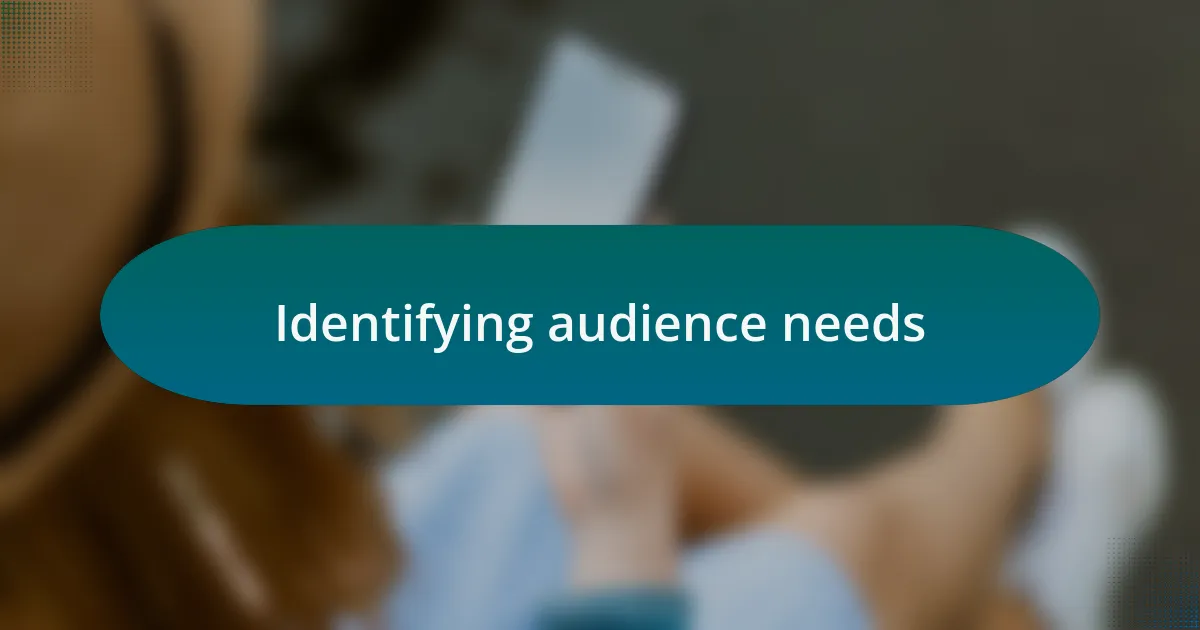
Identifying audience needs
Identifying audience needs begins with active listening. I often start by conducting pre-workshop surveys or informal chats to gauge participants’ interests and pain points. For instance, in one workshop, I discovered that many attendees struggled with time management in tech projects. Recognizing this, I dedicated a portion of the workshop to effective strategies and tools that could help them, which not only sparked lively discussions but also provided immediate value.
Another vital aspect is observing body language during initial interactions. I remember a situation where I sensed a group of attendees was more interested in hands-on coding exercises rather than theoretical concepts. By adjusting my approach on the fly, I incorporated live coding demonstrations, and the atmosphere shifted to one of excitement. Isn’t it fascinating how one simple observation can pivot the entire energy of a session?
Lastly, I encourage creating an open dialogue right from the start. I ask participants about their expectations and tailor the workshop dynamically. During one session, a participant shared their desire for a deeper dive into machine learning applications. I paused to pivot the focus, and that brief adjustment led to enriching conversations that lasted well beyond the event. This engagement not only caters to their needs but fosters a sense of ownership in the learning experience.
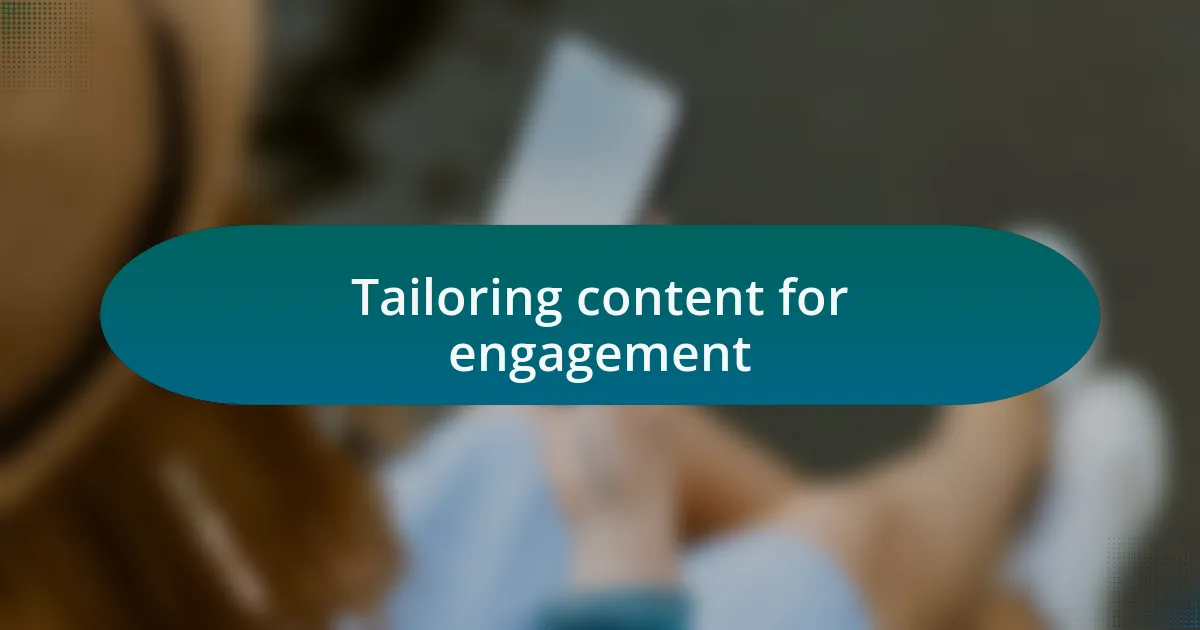
Tailoring content for engagement
Tailoring content for engagement requires a deep understanding of the audience’s preferences and learning styles. For example, during a workshop focused on agile methodologies, I aimed for a balance between theory and practice. I transitioned between interactive discussions and group activities, which not only maintained high energy levels but also created a collaborative environment. Have you ever experienced that moment when a participant’s eyes light up during a hands-on activity? It’s truly rewarding.
I also find that integrating real-world examples relevant to the audience’s industry boosts engagement significantly. In one session about cybersecurity, I shared a story about a recent data breach that impacted a local startup. The shared experience sparked a lively debate, allowing participants to connect theoretical knowledge with the tangible issues they faced daily. Seeing their faces change as they realized the importance of what they were learning was an unforgettable moment.
Finally, incorporating interactive technology can significantly elevate engagement levels. During a workshop on digital marketing analytics, I used live polls to gather real-time insights, highlighting diverse perspectives within the group. It was invigorating to witness participants actively interacting with the content and with each other, discussing which metrics impacted their businesses most. Have you ever thought about how small changes in format can light up a room?
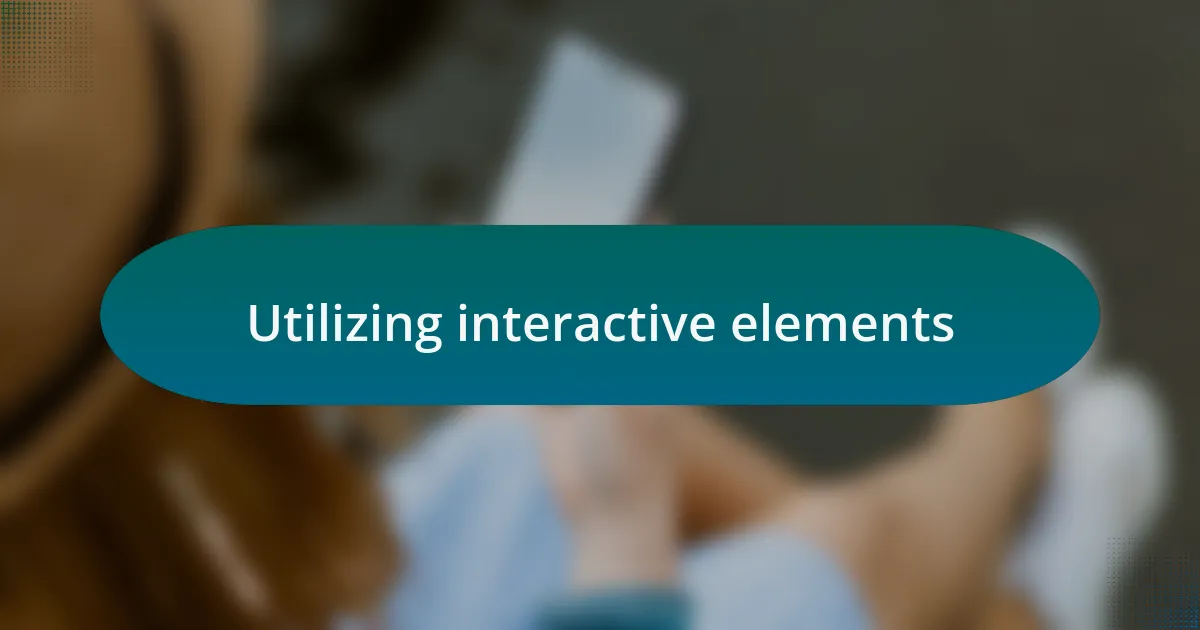
Utilizing interactive elements
Utilizing interactive elements can transform the atmosphere of a workshop. I remember a session on machine learning where I incorporated a coding challenge into the agenda. Participants were split into teams, and as they scrambled to solve problems, I witnessed this incredible camaraderie unfold. The excitement in the room was palpable; everyone was engaged, laughing, and learning from each other. Isn’t it amazing how a simple challenge can foster such collaboration?
Another powerful interactive tool I often use is audience feedback systems, like digital whiteboards or anonymous feedback apps. During a recent workshop on cloud computing, I encouraged attendees to post their questions anonymously. This led to a candid discussion about concerns and confusions that many had but hesitated to voice. The relief on their faces as they finally shared their thoughts was invaluable. Have you ever considered how making it easier for participants to speak up could change the dynamics of your sessions?
Finally, gamification is a concept that has enriched my approach to workshops. I created a quiz game related to data privacy laws in a legal tech workshop. As participants competed for small prizes, the energy in the room was through the roof. They weren’t just absorbing information; they were actively engaging with it in a fun and memorable way. Have you noticed how games can break barriers and make complex topics more approachable?
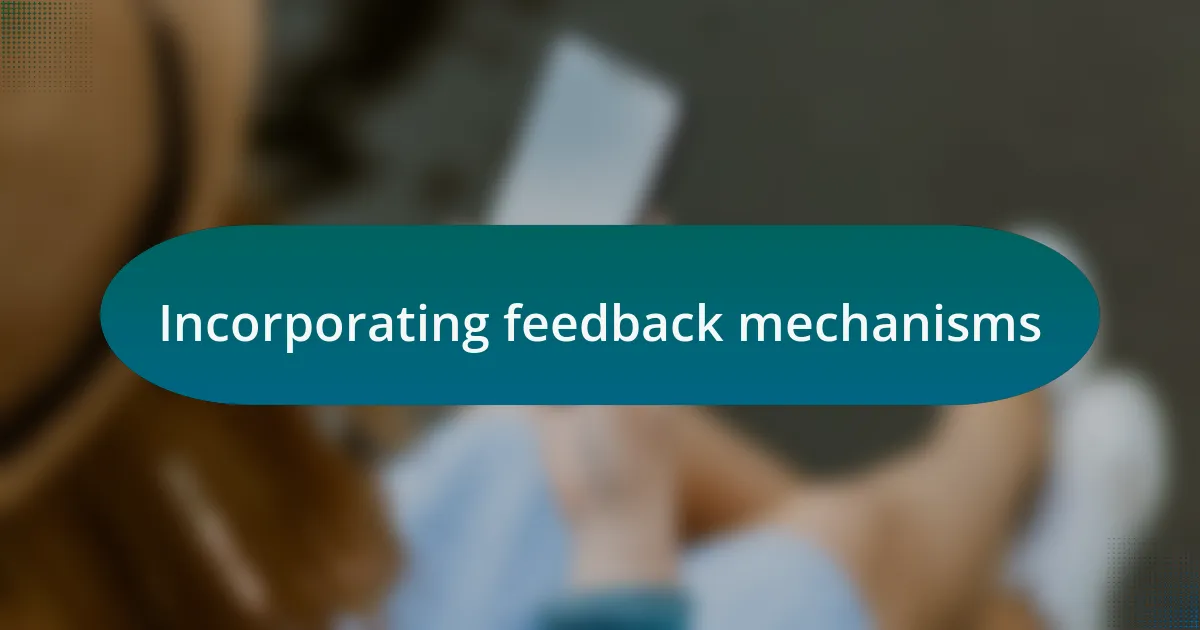
Incorporating feedback mechanisms
Incorporating feedback mechanisms is crucial for adapting workshops to the specific needs of diverse audiences. I recall a workshop where I utilized real-time polling tools to gauge participant understanding of coding concepts. The instant feedback allowed me to pivot my teaching approach on the fly, ensuring everyone stayed on the same page. Have you ever felt the power of adjusting your message in response to your audience’s needs?
One of my favorite feedback methods is using post-it note walls for reflective insights. After a session on cybersecurity, I encouraged attendees to share their takeaways and lingering questions on sticky notes. The wall quickly filled up, revealing common themes and unique insights. This visual representation sparked valuable discussions that wouldn’t have surfaced in traditional feedback forms. How often do we overlook the potential of physical interaction in gathering impactful feedback?
Lastly, I have found that follow-up surveys can provide a wealth of information after the excitement of the workshop fades. After a recent event focused on artificial intelligence, I sent out a simple survey asking participants what worked for them and what didn’t. The responses guided me in fine-tuning future sessions and helped me connect better with my audience. Have you considered how this type of reflection can enhance your future workshop experiences?
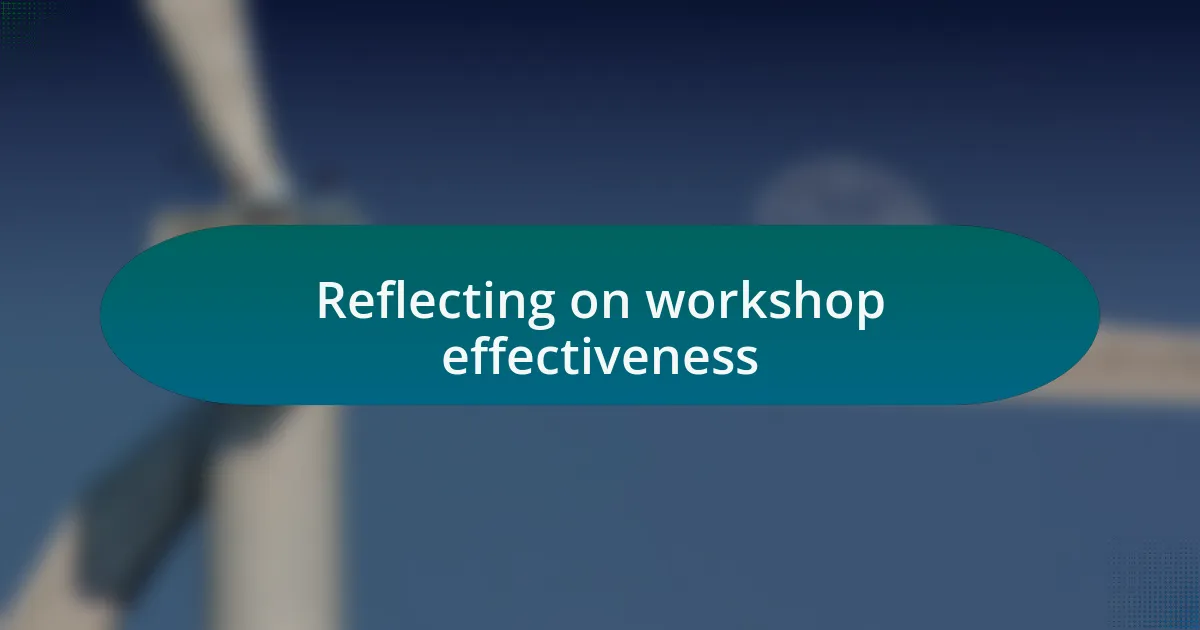
Reflecting on workshop effectiveness
Reflecting on workshop effectiveness is an ongoing journey that I truly value. I once attended a technology workshop where the facilitator opened the floor for candid discussions about what resonated with us. This choice not only built a rapport but allowed me to articulate what I found most impactful. Have you ever left a workshop wondering how others felt about it? I learned that the real magic happens in those honest exchanges.
Another approach I’ve found beneficial is dedicating a few minutes at the end of each session for informal debriefing. In one workshop, as we explored the latest trends in cloud computing, I encouraged participants to share their immediate thoughts. Their enthusiasm and varied perspectives offered me insights I hadn’t anticipated. How can we harness such spontaneous feedback to enrich our future events?
I also believe in stitching together qualitative and quantitative data when reflecting on effectiveness. After delivering a workshop on data visualization, I combined participant scores and their qualitative remarks for a more nuanced review. I used this information to tweak content that I originally thought was spot-on. Have you ever discovered that something you were confident about didn’t resonate as strongly as you thought? It’s a humbling experience that ultimately drives improvement.